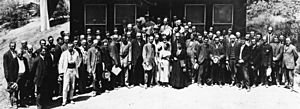Hugh Newall facts for kids
Quick facts for kids
Hugh Frank Newall
|
|
|---|---|

Newall at the Fourth Conference International Union for Cooperation in Solar Research at Mount Wilson Observatory, 1910
|
|
| Born | 21 June 1857 |
| Died | 22 February 1944 |
| Nationality | British |
| Alma mater | University of Cambridge |
| Scientific career | |
| Fields | Astrophysics |
| Institutions | Cavendish Laboratory |
Hugh Frank Newall (born June 21, 1857 – died February 22, 1944) was a British scientist who studied the stars and space. This field is called astrophysics. He became a professor at University of Cambridge in 1909. His father, Robert Stirling Newall, was also a famous astronomer.
Contents
Who Was Hugh Frank Newall?
Hugh Frank Newall was a brilliant scientist who spent his life studying the universe. He was known for his work with a very large telescope. He helped set up important astronomy centers in England. Newall was also a member of the Royal Society, a group for top scientists.
Early Life and Education
Hugh Frank Newall was born in 1857. He went to Trinity College, Cambridge, a famous university. There, he studied both mathematics and natural sciences. After finishing his studies, he worked as a school teacher for a short time.
A Giant Telescope and a Big Decision
Hugh's father, Robert Stirling Newall, owned a huge telescope. It was a 25-inch refractor telescope, which means it used lenses to gather light. At the time, it was the biggest telescope in the world! This amazing telescope would play a huge part in Hugh's life.
In 1889, the University of Cambridge was offered this telescope. However, they said they didn't have enough money to move it or use it. So, Hugh Newall decided to pay for the telescope to be moved himself! He then became the person who used and looked after it.
A Career in the Stars
Hugh Newall returned to Cambridge to work with J.J. Thomson. Thomson was a very famous physicist who later won a Nobel Prize. Newall started as an assistant in physics. Soon, he focused on astronomy because of his father's telescope.
From 1909 to 1928, Newall became the first Professor of Astrophysics at Cambridge. He did this job without getting paid! The giant telescope was set up next to another telescope at the Cambridge Observatory. Newall even built his home nearby, which became a popular place for other astronomers to visit.
Leading the Way in Astronomy
Newall was a very important person in the world of astronomy. He was the president of the Royal Astronomical Society from 1907 to 1909. This is a big honor for astronomers. In 1913, he also became the first director of the Solar Physics Observatory. This observatory studies the Sun.
Exploring Eclipses
Hugh Newall was very good at organizing and leading science projects. He led many expeditions to study solar eclipses. These are times when the Moon passes in front of the Sun. Scientists travel to different parts of the world to see and study them.
Later Life and Legacy
Hugh Frank Newall was elected a Fellow of the Royal Society in 1902. This was for his work on the light spectrum of a star called Capella. He was known more for helping other scientists and organizing big projects than for making new discoveries himself.
He was married twice. His second wife, Dame Bertha Surtees Phillpotts, was also a very smart scholar. She was the only woman on an important committee about Cambridge University in the 1920s. Hugh Frank Newall passed away in 1944 and is buried in Cambridge.

